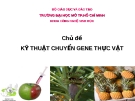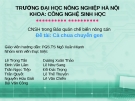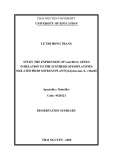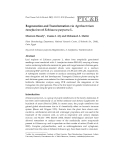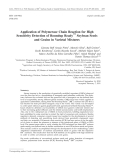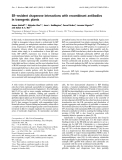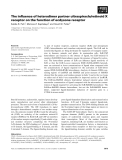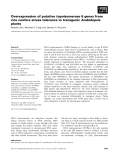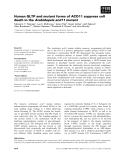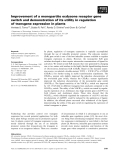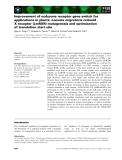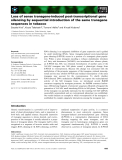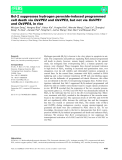
Transgenic plants
-
Công nghệ chuyển gen: là đưa một đoạn DNA ngoại lai vào gen của cơ thể đa bào, sau đó DNA ngoại lai này sẽ có mặt ở hầu hết các tế bào và được truyền lại cho thế hệ sau. Gen chuyển:(transgene) là gen ngoại lai được chuyển từ một cơ thể sang một cơ thể mới bằng kỹ thuật di truyền. GMP (genetically modified plant): thực vật biến đổi gen
 72p
72p  huuai_91
huuai_91
 25-08-2011
25-08-2011
 506
506
 193
193
 Download
Download
-
Transgenic plants result from the insertion of genetic material from another organism so that the plant will exhibit a desired trait. Recombinant DNA techniques (DNA formed by combining Cây trồng chuyển gen là cây trồng ngoài vật chất di truyền sẵn có của nó còn được chuyển thêm vật liệu di truyền từ các sinh vật khác để tạo ra các tính trạng mong muốn bằng cách sử dụng kỹ thuật tái tổ hợp ADN
 67p
67p  trautuongquan
trautuongquan
 25-02-2013
25-02-2013
 104
104
 18
18
 Download
Download
-
Glofish is the first transgenic animal approved to be consumed by human in the USA The insertion of different constructs of GFP into the fish genomes to give different green colors.The idea for recombinant DNA was first proposed by Peter Lobban, a graduate student of Prof. Dale Kaiser in the Biochemistry Department at Stanford University Medical School. The first publications describing the successful production and intracellular replication of recombinant DNA appeared in 1972 and 1973.
 54p
54p  zingzing09
zingzing09
 24-04-2013
24-04-2013
 77
77
 5
5
 Download
Download
-
Research objectives: Express GmCHI1A genes in transgenic soybean and create GmCHI1A transgenic soybean lines with higher isoflavone content than non-transgenic control plants.
 27p
27p  hobbsandshaw
hobbsandshaw
 09-06-2021
09-06-2021
 16
16
 4
4
 Download
Download
-
Laboratory for Phytopathology and Plant Protection, Katholieke Universiteit Leuven, Belgium; 2Institut de Pharmacologie et Biologie Structurale, UMR-CNRS 5089, Toulouse Cedex, France; 3Rega Institute, Laboratory of Molecular Immunology, Katholieke Universiteit Leuven, Belgium Fruits of elderberry (Sambucus nigra) express small quantities of a type-2 ribosome-inactivating protein with an exclusive specificity towards the NeuAc(a2,6)Gal/GalNAc disaccharide and a unique molecular structure typified by the occurrence of a disulfide bridge between the B-chains of two adjacent protomers....
 10p
10p  system191
system191
 01-06-2013
01-06-2013
 43
43
 3
3
 Download
Download
-
Agrobacterium tumefaciens is a Gram-negative, phytopathogenic bacterium and is characterized by an unique mode of action on dicotyledonous plants: it is able to genetically modify the host, and because of this feature, it is used as a tool for transgenic plants. Many experiments have demonstrated that lipopolysaccharides (LPSs) play an important role for the disease development, as they are involved in the adhesion process of the bacterium on the plant cell wall.
 4p
4p  system191
system191
 01-06-2013
01-06-2013
 32
32
 4
4
 Download
Download
-
Yellow stem borer has been identified as a major insect pest of deepwater rice, causing severe yield losses. Bt gene(s) from Bacillus thuringiensis have been proven very effective in pest resistance program. The use of transgenic plants expressing Bt gene(s) is now occupied effective approach to control insect infestation. We have successfully introduced a synthetic cryIA(b) gene into embryogenic calli of a deepwater indica rice variety, Vaidehi, by using the biolistic method of transformation.
 6p
6p  zingzing09
zingzing09
 24-04-2013
24-04-2013
 54
54
 1
1
 Download
Download
-
Leaf explants of Echinacea purpurea L. taken from aseptically germinated seedlings were inoculated with A. tumefaciens strains EHA105, carrying a binary vector conferring herbicide resistant bar gene and fungal resistant chitinase gene. Glufosinate ammonium‐resistant shoots were regenerated on a medium containing BAP and NAA at a concentration of 4.88 and 0.053 μM, respectively. A subsequent transfer of shoots to medium containing BAP was necessary for stem elongation and leaf development.
 11p
11p  zingzing09
zingzing09
 24-04-2013
24-04-2013
 35
35
 2
2
 Download
Download
-
Strong increase in the production of genetically modified organisms (GMOs) observed over the years has led to a consolidation of transgenic seed industries worldwide. The dichotomy between the evaluated risk and the perceived risk of transgenic use has defined their level of acceptability among different global societies. GMOs have been widely applied to agricultural commodities, among them the Roundup Ready™ (RR™) soybean line GTS 40-3-2 has become the most prevalent transgenic crop in the world.
 9p
9p  zingzing09
zingzing09
 24-04-2013
24-04-2013
 47
47
 4
4
 Download
Download
-
In this study, we demonstrate that the folding and assembly of IgG in transgenic tobacco plants is orchestrated by BiP (binding protein), an endoplasmic reticulum resident chap-erone. Expression of BiP and calreticulin was examined in transgenic tobacco plants that express immunoglobulin chains, either singly or in combination to form IgG anti-body. BiP mRNA expression was lowest in wild-type nontransformed plants and those that expressed immuno-globulin light chain alone.
 10p
10p  tumor12
tumor12
 22-04-2013
22-04-2013
 43
43
 3
3
 Download
Download
-
A pair of nuclear receptors, ecdysone receptor (EcR) and ultraspiracle (USP), heterodimerize and transduce ecdysteroid signals. The EcR and its nonsteroidal ligands are being developed for regulation of transgene expres-sion in humans, animals and plants. In mammalian cells, EcR:USP heterodimers can function in the absence of ligand, but EcR⁄retinoid X receptor (EcR:RXR) heterodimers require the presence of ligand for activa-tion.
 12p
12p  dell39
dell39
 27-03-2013
27-03-2013
 43
43
 4
4
 Download
Download
-
Employing transgenic plants as alternative systems to the conventional Escherichia coli, Pichia pastorisor baculovirus hosts to produce recombin-ant allergens may offer the possibility of having available edible vaccines in the near future. In this study, two EF-hand-type Ca 2+ -binding allergens from olive pollen, Ole e 3 and Ole e 8, were produced in transgenic Arabid-opsis thaliana plants.
 10p
10p  inspiron33
inspiron33
 25-03-2013
25-03-2013
 41
41
 3
3
 Download
Download
-
DNA topoisomerase 6 (TOP6) belongs to a novel family of type II DNA topoisomerases present, other than in archaebacteria, only in plants. Here we report the isolation of full-length cDNAs encoding putative TOP6 sub-units A and B from rice (Oryza sativassp.indica), preserving all the struc-tural domains conserved among archaebacterial TOP6 homologs and eukaryotic meiotic recombination factor SPO11.
 16p
16p  inspiron33
inspiron33
 23-03-2013
23-03-2013
 42
42
 4
4
 Download
Download
-
TheArabidopsis acd11mutant exhibits runaway, programmed cell death due to the loss of a putative sphingosine transfer protein (ACD11) with homology to mammalian GLTP. We demonstrate that transgenic expres-sion in Arabidopsis thalianaof human GLTP partially suppressed the phenotype of theacd11null mutant, resulting in delayed programmed cell death development and plant survival.
 11p
11p  galaxyss3
galaxyss3
 07-03-2013
07-03-2013
 48
48
 4
4
 Download
Download
-
In plants, regulation of transgene expression is typically accomplished through the use of inducible promoter systems. The ecdysone receptor (EcR) gene switch is one of the best inducible systems available to regulate transgene expression in plants.
 16p
16p  media19
media19
 06-03-2013
06-03-2013
 39
39
 3
3
 Download
Download
-
We reported earlier that ectopic expression of CAP2, a single AP2 domain containing transcription activator from chickpea (Cicer arietinum)in tobacco improves growth and development, and tolerance to dehydration and salt stress, of the transgenic plants.
 11p
11p  vinaphone15
vinaphone15
 25-02-2013
25-02-2013
 38
38
 2
2
 Download
Download
-
Gene switches have potential applications for the regulation of transgene expression in plants and animals. Recently, we have developed a two-hybrid ecdysone receptor (EcR) gene switch using chimera 9 [CH9, a chi-mera between helices 1–8 ofHomo sapiensretinoid X receptor (HsRXR) and helices 9–12 ofLocusta migratoriaRXR (LmRXR)] as a partner for Choristoneura fumiferanaEcR (CfEcR).
 11p
11p  viettel02
viettel02
 19-02-2013
19-02-2013
 32
32
 2
2
 Download
Download
-
RNA silencing is an epigenetic inhibition of gene expression and is guided by small interfering RNAs. Sense transgene-induced post-transcriptional gene silencing (S-PTGS) occurs in a portion of a transgenic plant popula-tion. When a sense transgene encoding a tobacco endoplasmic reticulum x-3 fatty acid desaturase (NtFAD3) was introduced into tobacco plants, an S-PTGS line, S44, was obtained.
 9p
9p  mobifone23
mobifone23
 18-01-2013
18-01-2013
 46
46
 3
3
 Download
Download
-
Hydrogen peroxide (H2O2 ) is known to be a key player in apoptosis in ani-mals. The components and pathways regulating H2O2-induced programmed cell death in plants, however, remain largely unknown. In the present study, rice transgenic lines overexpressing Bcl-2, a human apoptotic sup-pressor, were obtained.
 14p
14p  cosis54
cosis54
 08-12-2012
08-12-2012
 39
39
 3
3
 Download
Download
-
Nghiên cứu tạo giống bằng các phương pháp chuyển gen hiện đã thu được rất nhiều thành công ở các phòng thí nghiệm trên thế giới. Một số nghiên cứu về chuyển gen đã được triển khai nghiên cứu ở nước ta. Tuy nhiên, hầu hết các nghiên cứu đều tập trung vào một số đối tượng cây thực phẩm hoặc cây công nghiệp như: lúa, ngô, cà chua, bắp cải, đu đủ, bông vải… (Đặng Trọng Lương, 2001), (Lê Trần Bình, 2005)....
 8p
8p  tanvuong5obiotech
tanvuong5obiotech
 14-10-2010
14-10-2010
 2962
2962
 81
81
 Download
Download
CHỦ ĐỀ BẠN MUỐN TÌM









